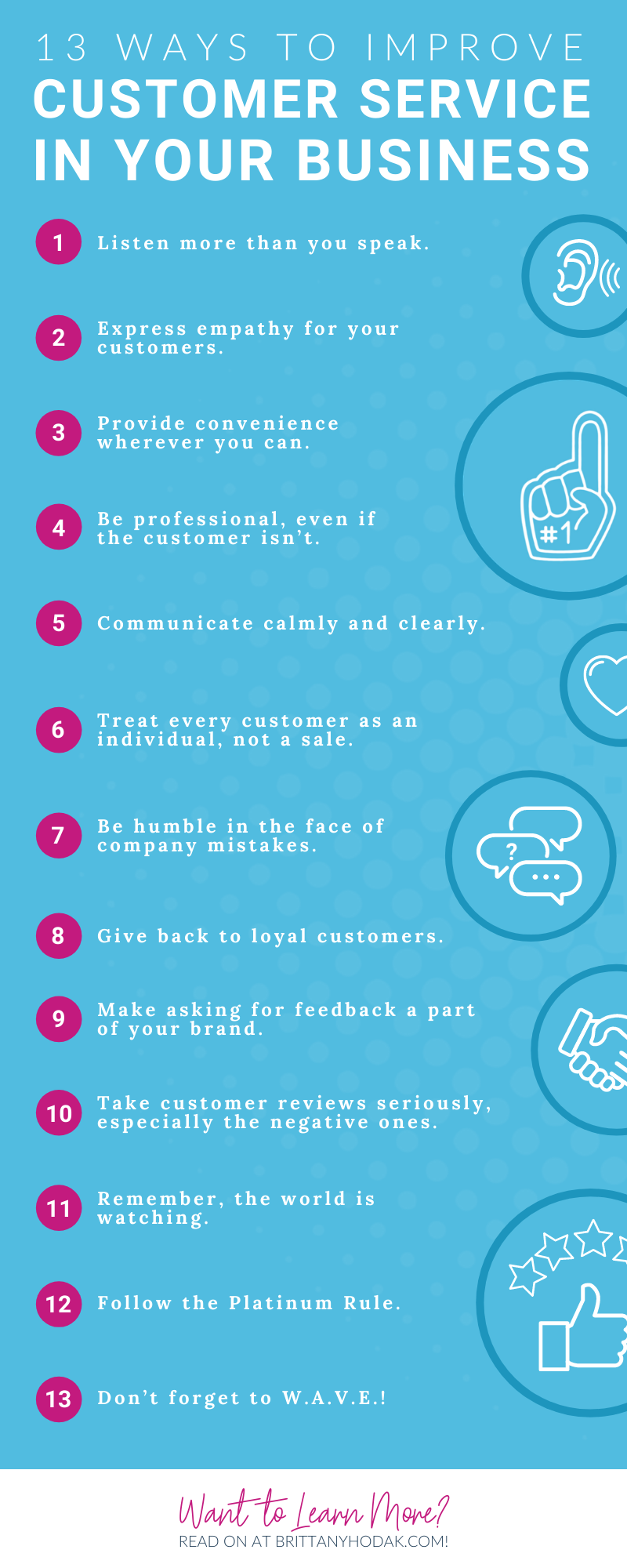When managing or supporting a business, there are countless benefits to providing exceptional service for your customers. From bringing in referrals to charging higher prices, high-quality customer service can mean the difference between a business that barely makes it by and a flourishing brand that consistently thrives. This guide covers thirteen ways to improve customer service in your business. If you’re already doing these things, congratulations! You’re on the right track. If these tactics aren’t currently part of your customer service repertoire, challenge yourself and your team to incorporate them.
- 1. Listen more than you speak.
- 2. Express empathy for your customers.
- 3. Provide convenience wherever you can.
- 4. Be professional, even if the customer isn’t.
- 5. Communicate calmly and clearly.
- 6. Treat every customer as an individual, not a sale.
- 7. Be humble in the face of company mistakes.
- 8. Give back to loyal customers.
- 9. Make asking for feedback a part of your brand.
- 10. Take customer reviews seriously, especially the negative ones.
- 11. Remember, the world is watching.
- 12. Follow the Platinum Rule.
- 13. Don’t forget to W.A.V.E.!
1. Listen more than you speak.
The first way to improve customer service in your business is to listen more than you speak. As any good salesperson will tell you, most customers aren’t just interested in your product or service. They’re also interested in you, as a company, and the values you represent. As a result, demonstrating that you care for them – as people, not just potential customers – is a sure way to win their approval if not also make sales. It’s also an easy way to illustrate that your company values aren’t merely sales slogans. They’re guidelines for your team and a genuine code of conduct for interacting with every new or existing customer that walks through the door. This obviously doesn’t apply literally for virtual companies, but you know what I mean. Actual doors are not required for excellent customer service. 😁
One way to communicate customer care is by practicing active listening, or the “80/20” rule. In a nutshell, this rule recommends that you spend 80% of your conversation with a customer simply listening to them. With the other 20%, you confirm that you hear their point of view and ask any clarifying questions. This allows the customer adequate time to express their questions or concerns without feeling rushed or ignored. It also allows you to gain a true understanding of their problem. Who knows? Maybe it’s an easy fix that could dramatically improve your customers’ experience, and you didn’t even know it was there!
In any case, taking the time to truly listen to your customers is a benefit for them and for you. From customer experience insights to product improvements, your greatest source of information often comes not from within your own team but from those you serve. Plus, everyone likes to feel heard and appreciated, including your customers.
2. Express empathy for your customers.
Speaking of caring, another way to improve customer service in your business is to be empathetic. Like actively listening to your customers, being empathetic and understanding can go a long way in building a positive image of your company. This is especially true when you promote a culture of empathy within your own team, as a customer is guaranteed a compassionate response no matter which employee(s) they interact with.

One of the best examples of this is pet supply brand Chewy – one of my favorite companies and a leader in customer experience for pets and people. With more than 15,000 employees, Chewy is one of the largest and most recognizable pet supply websites in the country. It also has a reputation for being the most kind-hearted. Much of this recognition comes from past clients, who have received flowers or refunds when their pet passed away and their products from Chewy were no longer needed. In these instances, Chewy’s team has gone above and beyond to express their empathy for a customer’s loss. Because of this, they’ve not only succeeded in helping a customer through a difficult time but also ensured that those customers continue purchasing through Chewy when they’re ready to adopt their next furry friend…and earned lots of goodwill and organic referrals in the process.
Likewise, expressing empathy to your customers’ questions or concerns is a sure way to build trust with them and, in doing so, begin a long-lasting relationship. Remember, when customers consider purchasing from your company, they’re looking at your values as well as your products and services. What better value is there than authentic appreciation and understanding for others?
3. Provide convenience wherever you can.
The third way to improve customer service in your business is through convenience. If you’re managing a storefront, the term “convenience” starts with aspects of the store itself, such as cleanliness and easy access to products. On the other hand, if your business is virtual, convenience typically involves a website that’s easy to navigate and clear descriptions of your products and/or services. However, for both types of businesses, there are three things to keep in mind above all: communication, transparency, and a streamlined purchasing process.
The first two, communication and transparency, are especially important pre-sale. Communication refers to the ease with which a customer can reach your team members. In a store, they should be able to find a store associate in less than a minute, and, online, they should have easy access to a company phone number, email address, or chat channel. After contacting a member of your team, transparency means truthful and unassuming answers to a customer’s questions. Even if they’re not the answers the customer may want to hear, sharing the truth will save them time in the long run and help them get to the product or service that is the right fit.
The last component of convenience, a streamlined purchasing process, builds off of communication and transparency. For this step, your goal is to make the customer’s experience – from their first to their last point of contact with your company – as pleasant and straightforward as possible. If they have a question, provide an honest answer in a timely manner. If they have a concern, listen patiently, and provide clarification where needed. In short, the more convenient you can make the customer’s experience, the more likely they are to make a purchase (or become a recurring customer).
4. Be professional, even if the customer isn’t.
The fourth way to improve customer service in your business is by reinforcing professionalism within your organization. Although it sounds basic, being professional when you’re in a customer-facing job isn’t always easy. This is especially true when the customer you’re serving isn’t behaving in a professional way or when you have little support from your fellow team members. Consequently, it’s important that everyone affiliated with your business is empowered to serve customers with the same level-headedness and integrity.

If you’re unsure how to best maintain a professional demeanor with an inconsiderate customer, there are a handful of things you can do to deescalate the situation. Below are a few of my personal recommendations from my own experience in customer service:
- Let harsh words roll off your back. When a customer is upset, they’re usually angry with the situation or an unrelated matter, not you.
- Rise above their behavior. If a customer is behaving in an insulting or childish manner, lowering yourself to their level will not solve the problem.
- Back yourself up. Whether it’s through email, Zoom meetings, or writing, leave a trail of your communication with a customer. That way, you cover your own you-know-what in the event that they complain to your supervisor.
- Follow company protocol. Again, any unprofessional customer is a lot easier to serve when you know you have support from your team.
Summarily, when you want to improve customer service within your company, focus on the bad experiences as well as the good ones. Obviously, it would be wonderful if all customers were a joy to serve. However, that isn’t the case, and the better prepared you and your team are for negative experiences, the more professionally you’ll be able to handle them when they pop up.
5. Communicate calmly and clearly.
That brings me to the fifth way to improve customer service in your business: communication. As mentioned previously, communicating calmly and openly with your customers is a win for both you and them. For one thing, providing open communication generally makes customers more comfortable coming forward with questions or problems. This allows them to purchase with confidence, knowing they can come back to you if they’re unsatisfied, and you’ll do everything you can to make things right. For you, this also means better representation of your brand and your products/services. After all, living out positive values like “honesty” and “transparency” create happy customers, and happy customers are more likely to share positive messages about your brand.
To ensure clear communication, make sure, first and foremost, that you are easy to reach. If you have a company phone number, clarify who is responsible for answering which types of calls and institute a “call back time” (ideally within 24 hours). If you have a general “support@” email address, designate team members to manage it and, again, set a definite timeframe for replies. Ideally, customers should be able to easily find your contact information if they have a question or concern. They should also be aware of when you are available and how soon they can expect a response.
Additionally, besides communicating clearly after a question or concern has been raised, aim to do so beforehand when possible. If you can see a potential inconvenience on the horizon, communicate it to your customers along with an apology and a solution to it. That way, even though they won’t be able to avoid it, they’ll know you’re looking out for them and doing your best to provide a positive experience.
6. Treat every customer as an individual, not a sale.
Another way to improve customer service within your organization is by shifting your mindset about the customers themselves. In many organizations, employees are hired initially with a set of numbers immediately thrown in their lap, including targets for quarterly, monthly, and sometimes even weekly sales. As a result, when facing a potential customer, it’s easy for employees to see a potential sale where they should see an individual person. From the customer’s view, this not only reflects poorly on the team member helping them. It also makes the company, as a whole, look bad, as company leadership endorsed that mindset in the first place.

To avoid creating this mindset within your own company, there are a few basic sales strategies to start reinforcing, if you haven’t already.
- Customize your messages to customers. By putting time into each message, you demonstrate to the recipient that you value them and are willing to put in the time to make sure they’re served well.
- Collect customer feedback about their communication preferences. Because some customers will prefer calls while others prefer emails, exceptional customer service means respecting those preferences.
- Be honest when someone isn’t a good fit. Every customer is unique, so your products, services, or brand won’t always be the solution to a customer’s problem, even though you may want them to be.
- Be personal! Remembering a customer’s personal details takes a little extra effort, but doing so is yet another way to show them that you’re looking for a lasting relationship.
In short, no matter what service you’re providing for your customers, remember that each customer and each experience is unique. Consequently, your team’s approach to customer also has to be flexible. That way, customer questions and concerns will be addressed with creativity and personalization, not a canned response.
7. Be humble in the face of company mistakes.
The seventh way to improve customer service in your business is by practicing humility. We’ve all seen corporate public apologies that absolutely missed the mark and two things are clear. First, if you don’t acknowledge who you negatively impacted, it’s hard for customers to believe you care. Second, if you don’t approach the apology with a “How can we do better?” attitude, it’s hard for customers to believe that your actions in the future will be improved.
According to public relations expert and co-author of The Apology Impulse, Sean O’Meara, the greatest thing you can offer your customers in the face of a mistake is authenticity. In a 2019 interview with Vox Media, O’Meara stated:
If you’re going to apologize, if you fail, you don’t get to speak to your own virtues. That adds insult to injury. If you’re apologizing, you’re conceding that you failed. If you’re conceding that you’ve failed, it’s just not the time to give yourself a character reference and say, “Hey. We’re great 99 percent of the time. We messed up here.” If the customer is the 1 percent — if you’re that person that’s really unlucky — that’s going to make them feel worse because they’re like, “Okay. I’m the person that suffered from this rare and exceptional failure, as you put it. That gives me no comfort whatsoever.”
In other words, when you apologize, you can’t simply say, “I’m sorry for the inconvenience”. You have to express empathy for your customers and admit that you let them down. Then, you have to show that you are actively working to solve the problem. That way, existing customers know that you genuinely value their support and potential customers know that you hold yourself and your team to admirably high standards.
8. Give back to loyal customers.
The eighth step to improving customer service in your company is giving back to your customers. Nowadays, having a “loyalty program” isn’t a unique feature in a brand. However, creating one generally comes with a whole list of positives, including recommendations, increased sales, and greater customer happiness. In fact, according to a 2019 customer experience study by XM Institute, loyal customers aren’t just more likely to choose your brand on a regular basis. They’re also more likely to refer others, try new offerings, and forgive you when something goes wrong. Combine that with the money you save retaining a current customer (compared to onboarding a new one), and the value of loyalty cannot be downplayed.

One example of a loyalty plan that’s been especially popular is the Starbucks Rewards Program. When it launched in 2009, this program was relatively innovative, compared to those of other brands, in that it functioned entirely through the Starbucks app. Whether you wanted to purchase a coffee, find your local Starbucks store, or redeem your existing rewards points (or, in their terminology, “stars”), everything could be completed through the app in a matter of minutes. For customers, this not only made for an efficient and enjoyable shopping experience but also allowed them to gain rewards at the same time. Win, win!
In the same way, creating a rewards program in your business can be a reliable way to provide exceptional service to your customers and, in doing so, encourage them to purchase from you again. Plus, your most loyal customers are also the ones that trust you the most. Rewarding that trust – in one way or another – is a key step in maintaining it and building your base of loyal patrons in the long run.
9. Make asking for feedback a part of your brand.
That brings me to the ninth way to improve customer service efforts within your team: Asking for feedback. Even if you, personally, think that your business is doing well, providing consistently great customer service means asking your customers what you could be doing to be even better. In fact, make it a part of your brand! Ideally, your customers should know that you don’t just welcome feedback. You also actively seek it out, so even if a given customer has been lost, you can do better in the future.
An older but undeniably wonderful example of this comes from the email newsletter at Naked Wines. In this 2013 email, after the recipient canceled their account, the Naked Wines team reached out with the following message:
In this example, there are a few things that make it almost irresistible to provide feedback. First, they start the email with a quick introduction and an eye-catching phrase, “If it wasn’t you…we’re guessing it was us.” Because you don’t normally see this phrase used in a professional capacity, it portrays Naked Wines as down-to-earth and humble. The second thing that makes it appealing is, quite simply, the humor. Looking at the ending, “Dear Naked Wines, you’re rubbish because…,” how do you not want to reply?
Along these lines, asking for feedback from your customers doesn’t have to be a gloomy component of your brand or your day to day operations. See it as an opportunity to make your customers laugh a bit and to learn how you could improve. That way, even if it’s sometimes hard feedback to hear, everyone wins.
10. Take customer reviews seriously, especially the negative ones.
After requesting feedback, the next way to improve customer service in your business is to take that feedback seriously. Although it can be tempting to think, “That’s just one person’s opinion,” in many cases, that single opinion is an opportunity to improve the experiences of many customers. A 2016 Pew Research Center study of consumers found that 82% of American adults “sometimes” or “always” read online reviews before making new purchases and, of those people, 65% believe reviews to be relatively accurate. That’s a lot of opportunities for potential customers to form an opinion of your brand, for better or worse. Therefore, seriously examining reviews (especially bad ones) is incredibly important.

Recently, for example, Coca Cola took into consideration a common theme in their reviews: Concern for the environmental impact of their products. Many of these products are sold in non-recyclable bottles or packaging, leading many of the brand’s environmentally-conscious customers to complain. Consequently, Coke adopted several pledges that focus on becoming more “green.” These include 100% recyclable packaging by 2025 and using 50% recycled content in its packaging by 2030. As a result, and in working to meet these goals, the Coke brand not only demonstrated their attention to customer concerns. They also proved their commitment to addressing those concerns and continually evolving to provide the best experience possible.
Likewise, when receiving customer feedback – written or verbal – try to put yourself in the customer’s shoes. Ask yourself, “If I were in their place, how would I feel?,” “What response would I hope for?” and “What changes would I want to see in my next experience with this company?” Then, put the answers to action, so future customers can avoid a similar experience (and you can avoid similar reviews).
11. Remember, the world is watching.
Improving customer service also means keeping in mind that the world is always paying attention. In recent years, with the increasing availability of smartphones, customers can, at any time, take a photo or shoot a video to encapsulate their experience with your company or with your products or services. Combine this with the growing popularity of social media platforms like Facebook, TikTok, Twitter, and Snapchat, and that experience can reach millions of existing and potential customers in a matter of minutes. That’s a lot of power — and a lot of risk — at any given time.
The best way to mitigate this risk is to empower your team members to provide consistently exceptional customer service. If a customer is angry or violent, everyone on the team should know how to react. If a customer has an emergency, the response from your team should be swift and uniform. No matter the situation, every person in your organization should understand the level of professionalism and patience expected of them. That way, no matter who a customer interacts with, your chance of bad press is minimized.
Summarily, everyone should strive to provide amazing customer service simply because it’s the right thing to do, but the stakes are much higher now that both good and bad customer service interactions are so often shared instantly online. To put it bluntly, any given customer is one tweet away from potentially making or breaking your business’ reputation for the foreseeable future. This is true even if you give stellar apologies, like those we covered in Step #7.
12. Follow the Platinum Rule.
Another way to minimize your chance of bad publicity is through the 12th way to improve customer service, the Platinum Rule. Penned in 1998, the Platinum Rule was originally conceived by Dr. Tony Alessandra and Dr. Michael J. O’Connor in their best-selling book, The Platinum Rule: Discover the Four Basic Business Personalities and How They Can Lead You to Success. This rule states that the traditional “Golden Rule,” “Do unto others as you’d have done unto you,” no longer applies in business. A better approach is to “Do unto others as ‘they’d’ have done unto them.” In other words, don’t focus on what you think is best for your customers. Focus on what they want, and craft your offerings and customer service accordingly.

For example, in early 2019, the beauty brand Sephora added color-coded shopping baskets to their European stores. Above these baskets were signs instructing patrons to choose a red basket if they wanted assistance during their time in the store and a black basket if they preferred to shop on their own. This allowed customers to choose the experience they preferred, rather than forcing them into a customer service experience that company leadership thought was best. In response, although they have yet to add them to their U.S. locations, retail customers worldwide are praising Sephora for their attention to customer preferences. After all, who wouldn’t shop at a store that acts with their patrons’ priorities in mind?
Likewise, as your business grows, make sure to keep your ear to the ground, when it comes to customer comments. If you’re regularly hearing, “I like this but it would be even better if…” take that request and make it happen! Even small changes to your brand or customer service can make a huge difference in a customer’s experience.
13. Don’t forget to W.A.V.E.!
Finally, the last and most important part of improving customer service within your team is ensuring that every customer feels Welcomed, Appreciated, Validated, and Engaged (or W.A.V.E. for short). Ideally, every customer shouldn’t just leave content with your products or services. They should also feel recognized and valued, like their support for your brand truly matters to you. My free ebook, The Superfan W.A.V.E, outlines steps for improving your customer service at every level of your business.
I hope these tips provided new insights to grow your business. However, the best ways to improve customer service always stem from your customers themselves. As long as your focus is on working to provide them with a better customer experience, you’re moving in the right direction. 👍






